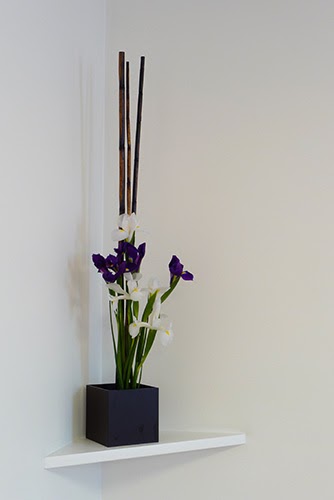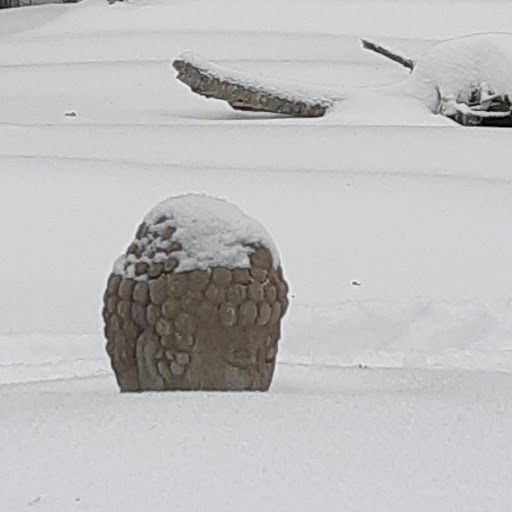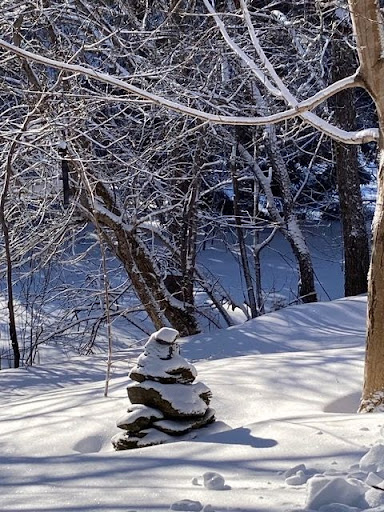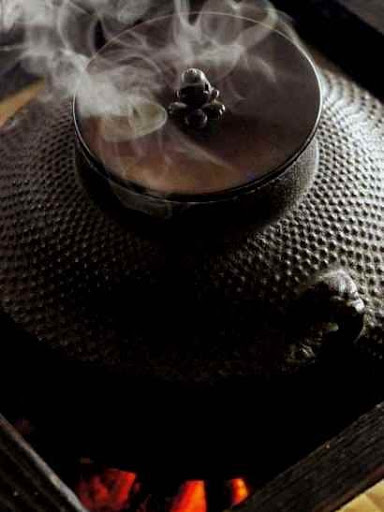eMirror Vol 26, No. 5 (2022-01-28)

Ikebana by Ven. Anzan Hoshin roshi,
Photograph by Ven. Fushin Comeau shramon
eMirror Vol 26, No. 5
Friday, January 28th
Edited by the Practice Council
The White Wind Zen Community:
An international community practising and teaching Dogen’s Zen since 1985.
You can explore this with or without specific works of art or art forms. Be interested in how you place a bowl in a cupboard, the placement of the stack of bowls in the area of the shelf. Put pine cones or stones near a door way or in a corner or on your desk. Find a black piece of wood. What configurations arise with one stone placed on the board. With two? Which is more alive dead? With three? Is four too many?
What about your bedroom, your living room, your couch? How you stand alone in an elevator? The sense of space in a crowded elevator? What is around or on top of or hanging off the screen of your computer monitor? On which shelf of the refrigerator should this container be placed? When you put down a cup on a counter or a table top, where is it in relationship to the edges? To other objects on the table?
As a point to help you to recognize the openness of seeing, notice two forms to the right and left edges of the peripheral vision. Notice them without directing the eyes at them. If you are walking down a street, flash out and notice a tree or building or car to the far right and to the far left. As you pass them, notice others and flash out. Do not turn the head, don’t shift the gaze, just notice.
In his text, “Jippo” or the Ten Directions, Dogen zenji says, “Zen Master Changsha Zhaoxian 1 said, ‘The whole world is reflected in this monk's eye.’2 This eye is the eye of the Awakened One, the Eye of Utter Reality. Although the Teachings were transmitted down to Ananda and so on, it is still the eye of Sakyamuni. All the presencing of experiences of the ten directions are contained within this Eye. It is all points of view and contains all eyes.”
Please, live with at least both eyes open.
1 Changsha Jingcen Zhaoxian (Chang-sha Chao-hsien, Keishin Chosa), n.d.
2 Also see Komyo: Luminosity for further on this saying.
-Ven Anzan Hoshin roshi, continuing Class Two: "Both Eyes Open" in the series "Zen Arts: The Flowering of the Senses", October 1999 Daruma-ki O-sesshin, Dainen-ji.
Upcoming Events
Fusatsu: February 2nd and February 16th.
Nehan Seven-day O-sesshin:
The Nehan O-sesshin begins on Friday, February 11th, at 8:00 p.m. and will end on Friday, February 18th at noon. Students attending (or sitting at home in alignment with the O-sesshin) are reminded to send their schedules to schedule@wwzc.org.
Hermitage:
The Roshi is currently in an extended period of "self-isolation" due to underlying health issues until the COVID-19 situation clarifies.
Beginning Instruction in Zen Practice:
For information concerning our Long-distance Training Program, please visit this Web Page: https://wwzc.org/long-distance-training-program
Retreats and Sesshin
Rev. Chiso anagarika sat her weekly semi-retreat on Tuesday, January 25th at her home in the Berkshires. Tarik Kaya sat a half-day retreat on Saturday, January 23rd at his home in Ottawa, Ontario.
If you would like to sit a retreat at home please follow the schedule outlined in this page: https://wwzc.org/retreat-schedule-public-students. After your retreat, please send an email to schedule@wwzc.org to confirm that you sat a retreat and include the duration and location.
Recorded Teachings Schedule
Saturday, January 29th to Saturday, February 4th
Saturday, January 29th: "Drawn In, Moving Forth": Zen Master Anzan Hoshin's Commentaries on Eihei Dogen zenji's “Bendowa: A Talk on Exerting the Way”: "The Problem With Dogen and Dogen's Problem" (18 of 28)
Sunday, January 30th: SAkN “Root Cycle Three” by Ven. Anzan Hoshin roshi: “The Presumption of Separateness” (teisho 5 of 8)
Monday, January 31st: “Every Breath You Take” by Ven. Shikai Zuiko o-sensei: “Seeing a Forest of Sorrowless Trees" (Dharma Talk 74)
Thursday, February 2nd: "Not Fade Away" by Ven. Jinmyo Renge sensei
Saturday, February 4th: "Drawn In, Moving Forth": Zen Master Anzan Hoshin's Commentaries on Eihei Dogen zenji's “Bendowa: A Talk on Exerting the Way”: "No Ghosts" (19 of 28)
Listening to Teisho and Dharma Talks
Associate and general students should continue to follow the recorded Teachings schedule for the sitting you were attending at the monastery, and listen to that during your home practice.
You can access the online Recorded Teachings Library at wwzc.org/recorded-teachings-schedule.
You can also use the streaming site at app.wwzc.org to live stream recordings from the online Library. If you have forgotten your password or need assistance with accessing the recorded Teachings, please email schedule@wwzc.org.
Please note that teisho should be listened to in the correct order and with none missed out as themes, metaphors, questions raised and answered evolve in spirals throughout the series.
Recorded Teachings for Public Access
While most of the online Recorded Teachings library is password-protected and only accessible to students of the Lineage of Zen Master Anzan Hoshin, a small selection of MP3 recordings of teisho are accessible to the public at wwzc.org/recorded-teachings Additional recordings will be uploaded periodically. MP3 recordings of four recorded teisho by Ven. Anzan Hoshin roshi are currently available:
Dharma Position https://wwzc.org/dharma-position
Eyes See, Ears Hear https://wwzc.org/eyes-see-ears-hear
Embarrassment https://wwzc.org/embarrassment
Ven. Anzan Hoshin roshi's reading of his translation of Eihei Dogen zenji's “Bendowa: A Talk on Exerting the Way”: https://wwzc.org/bendowa-talk-exerting-way
Wolfville Zazenkai

Buddha Rupa Has Had It Up To Here,
Photograph by Charlane Bishop

Stupa, photograph by Rev. Zenki Hope-Simpson anagarika
Translations and Texts

Photograph of Ven. Anzan Hoshin roshi at Daijozan, mid-1980s,
by Ven. Shikai Zuiko sensei
Ven. Anzan Hoshin roshi has recently completed translation work on some shorter texts by Eihei Dogen zenji from the Shobogenzo. The work on these particular texts is based upon the literal translations that he worked on with Joshu Dainen roshi at Hakukaze-ji around 1977-78 followed by many years of putting them down, picking them up, and polishing. Naturally, more essential texts such as Uji, Genjokoan, Shinjin Gakudo and some 40 others were completed first and have been given extensive commentaries by the Roshi. This batch of texts includes Baike: Plum Blossoms, Ryugin: Howling Dragon, and Udonge: The Udumbara Blossoming and many others are nearing completion. Annotation details and successfully conveying them across various document formats are the issue at this point.
Work on Bussho: Buddha Nature, a very long and nuanced text by Dogen zenji, is ongoing.
Roshi is also finishing an update to the Saijo Shingi: The Deportment of Radiance, our manual of monastic training standards which is a supplement to the ancient Eihei Shingi and Keizan Shingi.
Painted Cakes
(do not satisfy hunger)
Begun by Ven. Shikai Zuiko o-sensei
Finished by Rev. Fushin Comeau shramon following her death

Continuing on with “Painted Cakes: A Zen Dictionary,” a limited edition text written by Anzan Hoshin roshi in the 1980s and last revised in 1994.
Sõji-ji (J): The monastery founded by Keizan zenji and one of the two head temples of the Sõtõ-shu. It was originally in Ishikawa prefecture but was destroyed by fire in 1888 and moved to Kanagawa prefecture.
Posted January 21st, 2021. New entries are posted every two weeks.

Office of the Tenzo
Dogen zenji taught in the Tenzo kyokun: Instructions for the Tenzo (https://wwzc.org/dharma-text/tenzo-kyokun-instructions-tenzo) that the work of preparing and serving meals is "a matter for realized monks who have the mind of the Way or by senior disciples who have roused the Way-seeking mind." In alignment with this, part of Zen Master Anzan Hoshin's samu for the Community involves personally overseeing the activities of the ancient office of tenzo. Ven. Jinmyo Renge sensei serves as tenzo and Mishin godo and Saigyo ino offer assistance as tenzo-anja.
Monday Yakuseki:
White and brown Thai jasmine rice; bulgogi tofu (pressed tofu cut into slices, fried until golden-brown, chopped onion, poblano and red bell peppers, ginger, bulgogi sauce, shoyu; baechu kimchi.
Tuesday Yakuseki:
Vegetarian “fish” pie (sliced deep-fried tofu in a sauce made from roux mixed with blended cashews, lemon juice, Dijon mustard, apple cider vinegar, Old Bay seasoning, thyme, cayenne, oregano, lots of black pepper, with diced carrots, chopped Spanish onion, diced celery, minced garlic, peas and corn, topped with mashed Yukon gold potatoes; salad of Romaine lettuce, leaf lettuce, chicory, radicchio, sliced tomatoes, celery and radishes, served with white balsamic vinegar.
A second fish pie was made for those who wished to supplement their diet with fish and this contained chunks of cod and halibut, served with salad.
A third fish pie was made that contained fish, but was made with dairy-free mashed potatoes, served with salad.
Thursday Yakuseki:
Farfalle in garlic butter sauce (caramelised chopped onions, minced garlic, butter, olive oil, white wine, salt); greens and beans (gailan, thickly sliced Spanish onion, red bell pepper, Korean pepper, balsamic vinegar, salt, black pepper, rice bran oil); artichoke hearts mixed with black and green olives and lemon zest.

Thank You
If you would like to thank someone for a contribution they have made, please feel free to send an email to Jinmyo osho at rengezo at Gmail dot com, but be sure to type "eMirror" in the subject line.
From Mishin godo:
Thank you to Senbo for arranging WWZC media site access for new students. Thank you to Chantal Maheu for administrative bookkeeping samu. Thank you to Zenki anagarika, Jinen, and Charlane Bishop for work to improve the practice space and grounds at Wolfville, and for sending photos.
From Ian Richard:
Thank you to Saigyo ino, Fushin shramon, David and Leonardo for constantly demonstrating during Samu this past weekend a more sensible way to speak, to move, and to act. I often feel clumsy and hesitant by comparison, yet every little observation and interaction ends up being instructive and inspiring. Keep up the great work and great practice.
From David Gallant:
Thank you to Jinmyo sensei for preparing many delicious meals each week for residents, and for encouraging me to proceed with a professional business analysis certification program.
